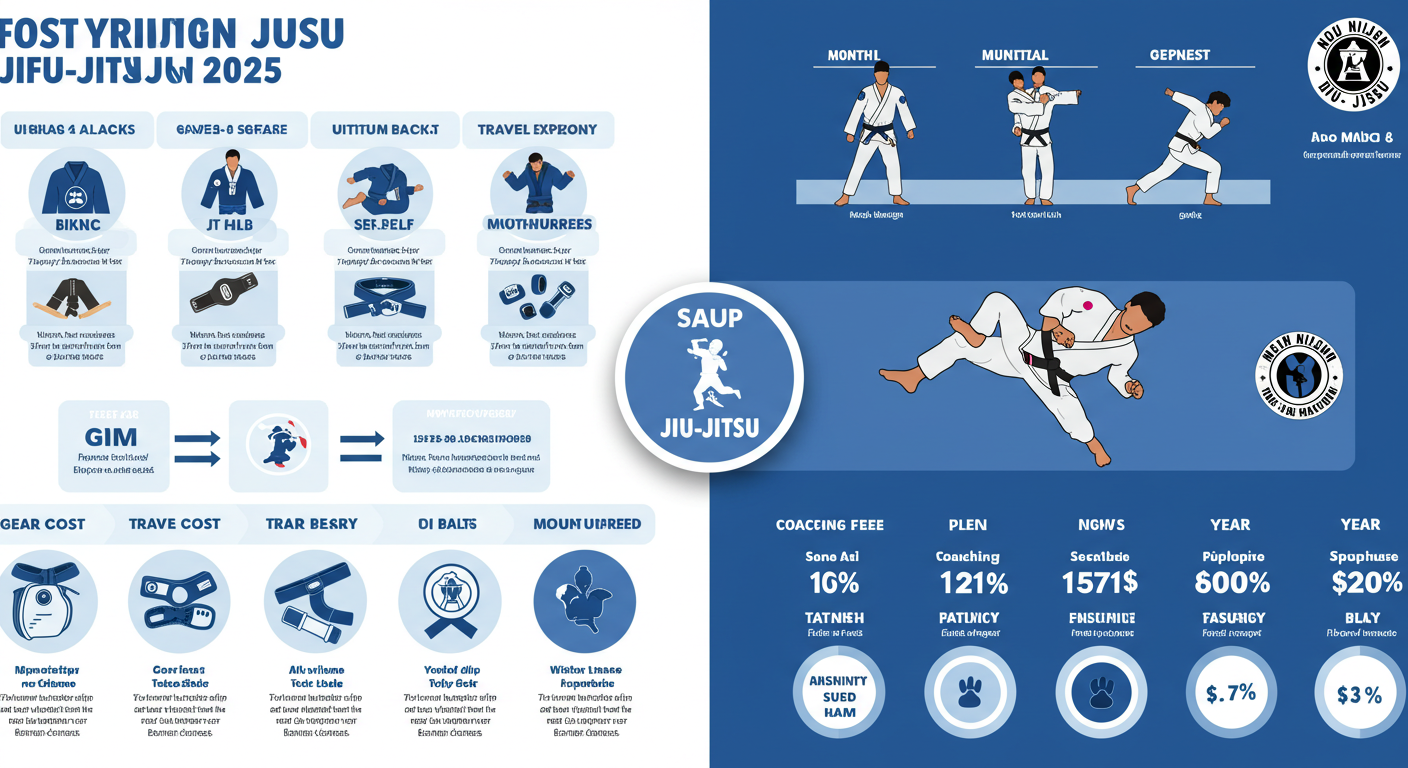If you’re thinking about joining a Brazilian Jiu Jitsu (BJJ) academy, one of your first concerns is likely how much is jiu jitsu going to cost. Whether you’re looking to train for self-defense, fitness, or competitive sports, jiu jitsu requires both time and financial commitment.
From monthly tuition fees to uniforms, equipment, and competition expenses, this guide will break down every aspect of the cost so you can budget with confidence and clarity before stepping onto the mat.
1. Monthly Training Fees: The Core Expense of Jiu Jitsu
What’s the Average Monthly Cost?
The bulk of your jiu jitsu expense will come from your academy’s monthly membership fee. Depending on your location and the gym’s reputation, costs typically fall between:
-
$90–$150/month in smaller towns or mid-sized cities
-
$150–$250/month in major urban centers or premium gyms
Prices also vary depending on whether the instructor is a black belt, offers specialized classes, or provides open mat time.
What’s Included in the Price?
Most academies offer unlimited access to beginner and intermediate group classes. Some also provide extras like:
-
Women’s-only sessions
-
Kids’ programs
-
Yoga or strength training
-
Open mat hours
Ask what’s included before signing up, as hidden costs can catch newcomers off guard.
2. Uniforms and Training Gear: Gi vs. No-Gi Jiu Jitsu
How Much Is a Jiu Jitsu Gi?
If your school practices gi jiu jitsu, you’ll need to purchase at least one uniform. Basic gi sets start at $70, while high-end brands like Shoyoroll or Origin can cost over $180.
What About No-Gi Training?
For no-gi training, you’ll need rash guards, grappling shorts, and spats. Budget around:
-
Rash guards: $30–$60
-
Shorts: $30–$50
-
Spats (optional): $30–$40
You may need multiples for laundry purposes, especially if you train several times a week.
3. One-Time and Recurring Gear Costs
In addition to uniforms, you’ll need:
-
Mouthguard – $10 to $30
-
Gym bag – $40 to $100
-
Mat sandals (flip flops) – $10 to $25
-
Athletic tape for fingers/toes – $5 to $15/month
-
Laundry detergent & supplies – Varies depending on training frequency
Though these seem minor, they can add up over time if not budgeted for.
4. How Much Is Jiu Jitsu for Kids?
For parents wondering how much is jiu jitsu for their children, kids’ classes are often slightly cheaper than adult programs. Here’s a breakdown:
-
Monthly tuition: $60–$120
-
Children’s gi: $40–$80
-
Belt test fees (if applicable): $20–$50 per test
Some academies offer family discounts, which can save you up to 10–20% per additional family member.
5. Private Lessons: Worth the Extra Cost?
How Much Are One-on-One Lessons?
Private instruction is an optional but powerful way to accelerate learning. A 60-minute session typically costs:
-
$50–$100 per session
-
Bulk packages: $400–$700 for 8–10 sessions
Privates are especially helpful before competitions or when correcting specific techniques that aren’t easily addressed in group classes.
6. Belt Testing and Promotion Fees
Most BJJ schools promote students based on attendance and performance, not formal testing. However, some do charge for belt upgrades:
-
Stripe promotions: Usually free
-
Full belt promotions: Can cost $50–$150, depending on the academy
Always ask about a school’s promotion policy before joining so you’re not surprised by extra charges.
7. Tournaments: Optional but Popular
How Much Is Jiu Jitsu Competition?
Competing is optional but a big part of the jiu jitsu experience for many practitioners. Common tournament expenses include:
-
Local tournaments: $40–$80
-
Major regional or IBJJF events: $100–$160
-
Travel & lodging (if required): Varies
-
IBJJF membership (if competing in official events): ~$40/year
Even participating in just two tournaments per year can add $300–$500 to your total cost.
8. Online Training: A Budget-Friendly Supplement
If your local options are limited or you want to study outside class, there are many great digital resources available:
-
BJJ Fanatics instructionals – $40–$150 per course
-
Grappler’s Guide membership – ~$120/year
-
YouTube channels (free) – Channels like Chewjitsu, BJJ Scout, and BJJ Library
Online training won’t replace live rolling but can help reinforce technique and concepts.
9. How Much Is Jiu Jitsu in Total? A Yearly Estimate
Let’s summarize an average year for a hobbyist practitioner training 2–3 times a week:
| Item | Estimated Cost (Per Year) |
|---|---|
| Membership ($150/month avg) | $1,800 |
| Gi and no-gi gear | $250–$350 |
| Gear and accessories | $100–$200 |
| Tournament entry (2/year) | $200–$300 |
| Belt testing (if any) | $50–$150 |
| Total (approx.) | $2,400–$2,800 per year |
This doesn’t include extras like travel, private lessons, or multiple gis.
10. Is Jiu Jitsu Worth the Price Tag?
So now that you know how much is jiu jitsu, the next question is—is it worth it? For most practitioners, the answer is a resounding yes.
You gain more than just physical fitness. You develop:
-
Discipline
-
Confidence
-
Resilience
-
Community
-
Self-defense skills
It’s a personal investment that pays off in countless mental, emotional, and physical ways.
Tips to Reduce Jiu Jitsu Costs
-
Look for trial classes or first-month discounts
-
Buy gently used gear or secondhand gis
-
Ask about family, student, or military discounts
-
Train consistently to make the most of your membership
-
Join team-based programs or volunteer at your gym for possible fee reductions
Conclusion: Understanding the Real Cost of Jiu Jitsu
Answering the question how much is jiu jitsu isn’t always simple. Costs vary depending on where you live, how often you train, and what kind of experience you want.
However, with proper planning and a smart approach to gear and memberships, Brazilian Jiu Jitsu can be a sustainable and life-changing practice. Whether you’re training to compete or just want to get in shape while learning a powerful martial art, it’s an investment worth making.

